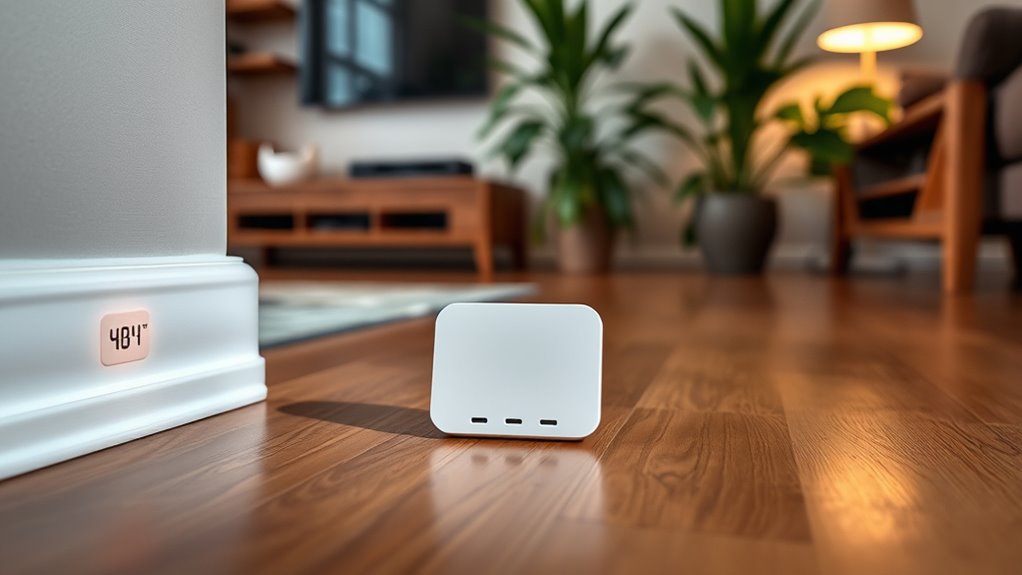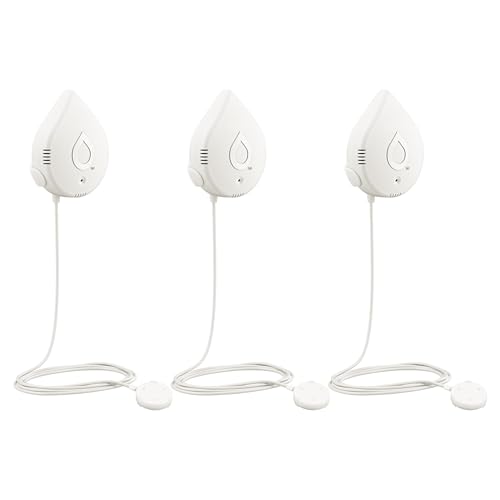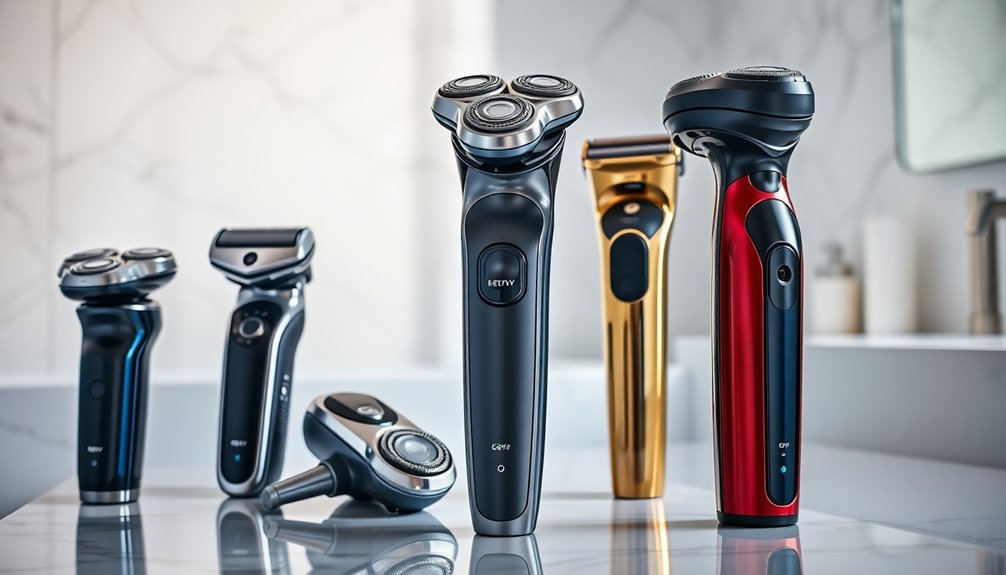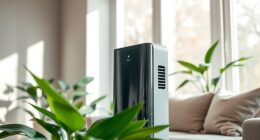I’ve tested various smart leak sensors and found that top options include Wi-Fi, Zigbee, Z-Wave, and LoRa-based devices, offering different ranges and features. For quick detection, waterproof sensors with loud alarms and app alerts work best. Long-range systems like YoLink are great for large properties, while Govee and Moen provide reliable, easy-to-install options for smaller spaces. If you want detailed insights, keep exploring to discover which sensors fit your home’s needs perfectly.
Key Takeaways
- Choose sensors with waterproof IP66 ratings for durability in humid or wet environments like basements and laundry rooms.
- Opt for Wi-Fi or LoRa-based sensors supporting multiple devices and long-range coverage for comprehensive home protection.
- Prioritize models with loud alarms (up to 110dB), instant notifications, and smart home integration for prompt leak detection.
- Consider easy-to-install, battery-powered sensors with multi-zone placement to monitor high-risk areas effectively.
- Select sensors compatible with major platforms (Alexa, Google, Apple HomeKit) for seamless automation and remote monitoring.
YoLink Water Leak Starter Kit with Hub and Sensors
If you’re looking for a reliable leak sensor system that can cover your entire home, the YoLink Water Leak Starter Kit with Hub and Sensors is an excellent choice. It includes a hub and four contact-based sensors designed for detailed leak detection at toilets, water heaters, sinks, and more. These sensors communicate via long-range LoRa technology, ensuring coverage even where Wi-Fi falls short. Setup is straightforward: connect the hub, register sensors through the app, and place them where needed. With a battery life of up to five years and support for over 300 devices, this system offers dependable, scalable leak detection to protect your home.
Best For: homeowners seeking a reliable, long-range leak detection system that integrates with smart home platforms and offers multi-year battery life.
Pros:
- Long-range LoRa communication (up to 1/4 mile open air) ensures comprehensive coverage across large properties.
- Easy setup via app with automatic device detection and QR code pairing.
- Durable, water-resistant sensors with multi-year battery life and scalable system supporting over 300 devices.
Cons:
- Requires a hub connected via Ethernet, which may complicate installation for some users.
- No built-in siren; audible alerts depend on adding external speakers or sirens.
- Compatibility limited to 2.4 GHz Wi-Fi networks; does not support 5G bands or Wi-Fi networks outside the standard 2.4 GHz frequency.
GoveeLife Smart Water Leak Detector 5 Pack
The GoveeLife Smart Water Leak Detector 5 Pack stands out as an excellent choice for homeowners with large properties or multiple vulnerable areas, thanks to its industry-leading 550m (1804ft) long-range wireless connectivity. Thanks to advanced Sub-1G tech, it maintains signals through five dense walls, making it ideal for expansive spaces like basements, garages, and outbuildings. The system includes a gateway and five sensors with a 5-year battery life, IP67 waterproof durability, and contact sensor technology. Customizable alarms up to 105 dB, along with instant push notifications via app, SMS, and email, ensure you’re alerted immediately to any leaks.
Best For: homeowners with large or multi-level properties seeking reliable, long-range water leak detection and instant alerts.
Pros:
- Industry-leading 550m (1804ft) long-range wireless connectivity ensures comprehensive coverage through multiple walls.
- 5-year battery life with minimal maintenance using 10 AAA alkaline batteries.
- IP67 waterproof sensors with customizable alarms and instant notifications via app, SMS, and email.
Cons:
- App interface may have small diagrams and instructions that could be improved for easier setup.
- Requires a stable 2.4G Wi-Fi connection for the gateway, which may be a limitation in some areas.
- Some users may find the initial setup and pairing process slightly challenging, especially in complex environments.
GoveeLife Smart Water Leak Detector 3 Pack
The GoveeLife Smart Water Leak Detector 3 Pack stands out for homeowners with large or multi-zone properties who need reliable coverage over expansive areas. Its advanced long-range connectivity (550m/1804ft) ensures signals pass through multiple walls, perfect for basements, garages, or outbuildings. The system includes three durable sensors with a five-year battery life, plus a gateway supporting 2.4 GHz Wi-Fi. Alerts come via loud 105 dB alarms, SMS, email, and app notifications. Easy to install, the sensors are waterproof and adjustable, providing peace of mind by dependably detecting leaks across multiple zones, even when you’re away.
Best For: homeowners with large, multi-zone properties seeking reliable, long-range leak detection coverage.
Pros:
- Exceptional long-range connectivity (up to 1804 ft) through walls, ideal for expansive areas
- Includes durable, waterproof sensors with a 5-year battery life for low maintenance
- Multiple alert methods (sound alarm, SMS, email, app notifications) ensure prompt response
Cons:
- Setup may be challenging for some users due to limited instructions
- Gateway supports only 2.4 GHz Wi-Fi, limiting compatibility with 5 GHz networks
- The app interface, while functional, can be small and less intuitive for some users
YoLink Water Leak Starter Kit with Hub and Sensors
Looking for a reliable leak sensor that can cover large areas and integrate seamlessly into your smart home? The YoLink Water Leak Starter Kit offers just that. It includes a hub and four sensors with 105 dB sirens, long-range LoRa technology, and instant alerts via app, SMS, or email. Compatible with Alexa, IFTTT, and Home Assistant, it supports over 300 devices, making it highly scalable. The sensors are waterproof, battery-powered with up to five years of life, and easy to install. The hub connects via Ethernet for stable operation, ensuring your home remains protected from water damage, no matter the size.
Best For: homeowners and property managers seeking a scalable, long-range leak detection system that integrates seamlessly with popular smart home platforms.
Pros:
- Long-range LoRa technology enables coverage up to 1/4 mile in open air and 1-3 km in urban environments, ideal for large properties.
- Compatibility with Alexa, IFTTT, and Home Assistant allows easy integration into existing smart home ecosystems.
- Easy installation with waterproof sensors powered by long-lasting batteries, and stable Ethernet-connected hub for reliable operation.
Cons:
- Some users report initial batteries arriving dead, requiring replacement before use.
- Setup can be complex for non-technical users, especially when scanning QR codes or configuring multiple devices.
- Battery lifespan may vary depending on environmental conditions, potentially requiring frequent replacements in high-moisture areas.
GoveeLife WiFi Water Leak Detector 2 (6 Pack)
If you want reliable water leak protection that’s easy to manage remotely, the GoveeLife WiFi Water Leak Detector 2-pack is an excellent choice. It offers smart connectivity with app and email alerts, so you’re instantly notified of leaks no matter where you are. Supporting up to six sensors with long-range LoRa technology, it’s perfect for large homes, basements, or outdoor areas. The detectors are highly sensitive, with loud alarms up to 100dB, and feature a waterproof IP66 rating for damp environments. With over five years of battery life and simple setup, it’s a cost-effective, user-friendly solution to prevent water damage proactively.
Best For: homeowners seeking reliable, remote water leak detection and prevention in large or moisture-prone areas.
Pros:
- Easy to set up and manage via the user-friendly GoveeHome app with real-time alerts
- Supports multiple sensors with long-range LoRa technology, suitable for large properties
- Loud alarms (up to 100dB) and high sensitivity for prompt leak detection
Cons:
- Potential false alarms in very humid environments due to high sensitivity
- The gateway may partially block outlets if plugged directly into standard outlets
- Batteries require replacement after more than 5 years, which, while long-lasting, still requires periodic maintenance
Aqara Water Leak Sensor for Smart Home Automation
For homeowners seeking a reliable and discreet water leak sensor that seamlessly integrates into their smart home setup, the Aqara Water Leak Sensor stands out. It’s a compact, wireless Zigbee device with highly sensitive probes that detect water levels as low as 0.5mm, instantly alerting you via app notifications and local alarms. It requires an Aqara Hub for operation and works with Apple HomeKit, Google Home, Alexa, and IFTTT. Easy to install without wiring or screws, its IP67 waterproof housing guarantees durability. With a battery life of about 2 years, it’s perfect for placement near appliances like washing machines, water heaters, or sinks to prevent water damage.
Best For: homeowners seeking a reliable, discreet, and easy-to-install water leak sensor that integrates seamlessly with popular smart home platforms for proactive water damage prevention.
Pros:
- Highly sensitive probes detect minimal water leaks as low as 0.5mm for quick alerts
- Easy to install without wiring or screws, suitable for various indoor locations
- Compatible with major smart home systems like Apple HomeKit, Google Home, Alexa, and IFTTT when paired with Aqara Hub
Cons:
- Requires an Aqara Hub for operation, limiting compatibility with third-party Zigbee hubs without limited functionality
- App setup for notifications can be complex, risking missed alerts if not configured properly
- Lacks a built-in siren or audible alarm beyond app notifications, which may not satisfy those seeking audible alerts
Govee WiFi Water Leak Detectors, 3 Pack
The Govee WiFi Water Leak Detectors, 3 Pack, stand out for homeowners who want reliable, real-time leak alerts via their existing WiFi network. These sensors connect seamlessly through a 2.4G Wi-Fi gateway supporting up to 10 sensors, making it easy to monitor multiple areas. With built-in probes for detecting leaks and drips, they’re perfect for basements, kitchens, or bathrooms. The app allows me to label each sensor for quick leak source identification. When a leak is detected, I get a loud 100dB alarm, email, and app notifications, ensuring I can respond immediately and prevent water damage.
Best For: homeowners seeking reliable, real-time water leak detection across multiple areas using existing WiFi connectivity.
Pros:
- Supports up to 10 sensors via a 2.4G Wi-Fi gateway, ideal for monitoring multiple locations.
- Loud 100dB alarm with adjustable volume and mute function for customizable alerts.
- App labeling feature allows quick identification of leak sources, enhancing response efficiency.
Cons:
- Only compatible with 2.4G Wi-Fi networks, limiting use in some newer or dual-band setups.
- Requires a WiFi connection to operate, so internet outages could impair alert delivery.
- Sensors need to be placed carefully to ensure optimal detection, which may require precise positioning.
X-Sense Wi-Fi Water Leak Detector with 3 Sensors & Base Station
The X-Sense Wi-Fi Water Leak Detector with 3 sensors and a base station stands out as an excellent choice for homeowners seeking reliable, whole-home water monitoring. It connects via 2.4 GHz Wi-Fi within a 1700 ft range and supports up to 50 sensors through the X-Sense Home Security App. With its IP66 waterproof rating and durable exterior, it’s perfect for humid spaces like kitchens and basements. The detector’s high sensitivity, real-time alerts, and loud alarms (up to 110 dB) ensure prompt leak detection. Easy to install and maintain, it provides peace of mind, backed by a 5-year warranty and lifetime support.
Best For: homeowners and property managers seeking reliable, whole-home water leak detection with easy setup and real-time alerts.
Pros:
- Easy installation with quick setup under 7 minutes and user-friendly app interface.
- Effective early leak detection with loud alarms up to 110 dB and real-time notifications via app, email, and text.
- Supports up to 50 sensors within a 1700 ft range, suitable for covering large or multiple areas.
Cons:
- Compatible only with 2.4 GHz Wi-Fi networks, requiring a guest network setup if using 5 GHz routers.
- Some users experienced initial pairing difficulties that needed troubleshooting or support.
- Battery life, while approximately 3 years, may vary if alarms are triggered frequently, leading to faster depletion.
WiFi Water Leak Detector with App Notification (Gateway + 6 Sensors)
If you’re looking for a reliable leak detection system that offers instant alerts and easy control via smartphone, the WiFi Water Leak Detector with App Notification (Gateway + 6 Sensors) is an excellent choice. It includes a compact gateway and six sensitive sensors that detect drips and flooding in areas like the basement, kitchen, or bathroom. The system supports up to 24 sensors over a 328-foot range and is easy to install without tools. Using the TUYA Smart App, you can customize alarms, label locations, and receive real-time push notifications, ensuring you’re instantly alerted to potential leaks and water damage risks.
Best For: homeowners seeking an easy-to-install, WiFi-enabled water leak detection system with real-time app notifications to prevent costly water damage.
Pros:
- Wireless, installation-free design with easy placement around leak-prone areas
- Supports up to 24 sensors over a 328-foot range for comprehensive coverage
- Customizable alerts, ringtones, and volume control via TUYA Smart App
Cons:
- Only compatible with 2.4GHz WiFi networks, not 5GHz bands
- Gateway (W13) supports only WD61 sensors, not WD60 models lacking WiFi/Bluetooth
- Some users may experience initial connection issues requiring network adjustments
GoveeLife WiFi Water Leak Detector 3 Pack
For homeowners seeking extensive water leak coverage, the GoveeLife WiFi Water Leak Detector 3 Pack stands out with its impressive long-range connectivity and smart alerts. It uses LoRa technology, supporting an open-air transmission of up to 1968 feet, allowing connections across large areas like basements or sheds. With two top probes and four bottom probes, it detects even small leaks and drips, triggering a loud 100dB alarm. You receive instant notifications via app, email, and voice commands through Alexa. Its IP66 waterproof rating and over 5-year battery life make it durable and reliable, providing thorough protection for your home.
Best For: homeowners with large properties or multiple water-sensitive areas seeking reliable, long-range leak detection and smart alert integration.
Pros:
- Supports LoRa technology with an open-air range of up to 1968 feet for extensive coverage
- Equipped with multiple sensor probes for high sensitivity to leaks and drips
- Offers real-time alerts via app, email, and voice commands, plus a loud 100dB alarm
Cons:
- Requires Wi-Fi connection for app and alert functionalities, which may not be ideal in areas with poor signal
- The initial setup and placement of multiple sensors can be time-consuming
- Does not specify if it includes additional smart home integrations beyond Alexa
TP-Link Tapo Smart Water Leak Detector
When choosing a smart water leak detector that offers quick responses and reliable alerts, the TP-Link Tapo T300 stands out. This compact, IP67 waterproof sensor detects leaks within 1 second using dual contact sensors with six sensitive probes. It connects via Wi-Fi, supports app alerts, and integrates seamlessly with Alexa and Google Home. With three alert volume levels up to 90 dB, it ensures you’re notified immediately of any leaks. Powered by two AAA batteries, it can last around three years. Its durable design makes it suitable for various locations, like under sinks or near water heaters, providing reliable, instant leak detection for peace of mind.
Best For: homeowners seeking a reliable, quick-responding smart water leak detector that integrates seamlessly with smart home systems and offers long battery life.
Pros:
- Detects leaks within 1 second with high sensitivity probes
- Supports app alerts, voice assistant integrations, and automation options
- Long battery life of approximately 3 years with easy setup
Cons:
- Requires a Tapo Hub for operation, adding an extra component to installation
- May need modification of legs for certain surfaces like concrete or carpet to ensure contact
- Initial setup can sometimes encounter local-only error issues, requiring customer support assistance
WiFi Water Leak Detectors 5 Pack
The WiFi Water Leak Detectors 5 Pack is an excellent choice for homeowners who want exhaustive protection without complicated setup. It includes five sensors and a hub that supports 2.4GHz WiFi networks, making it easy to connect via the Tuya Smart app. The sensors detect leaks with dual probes, one for dripping water and another for pooling, reducing false alarms. They send alerts within 150 feet indoors and up to 328 feet outdoors, notifying you instantly on your phone. With a loud 120dB buzzer, flashing lights, and customizable alerts, this system guarantees you’re always aware of potential water issues. It’s perfect for high-risk areas like sinks and pipes.
Best For: homeowners seeking comprehensive, easy-to-install water leak protection with remote alerts and customizable settings.
Pros:
- Supports up to 24 sensors for extensive coverage and home safety
- Dual-sensor technology reduces false alarms with early leak detection
- Easy setup via the Tuya Smart app and remote notifications
Cons:
- Only compatible with 2.4GHz WiFi networks, not 5GHz
- Requires AAA batteries, which need regular replacement
- Limited to a maximum of 24 sensors, may not cover very large properties
Moen White Flo Smart Water Leak Detector (3-Pack)
If you’re looking for a reliable way to protect your home from water damage, the Moen White Flo Smart Water Leak Detector (3-Pack) offers a smart, easy-to-install solution. These compact detectors monitor for leaks, humidity, and extreme temperatures, sending instant alerts via the Moen app. They connect wirelessly within a 48-inch range, making placement flexible, especially behind appliances or in sump pits. The kit includes three detectors, remote sensing discs, mounts, and batteries. Many users find setup straightforward, and the real-time notifications provide peace of mind. However, some experience connectivity issues, especially with Wi-Fi, and battery replacements are needed roughly every six months.
Best For: homeowners seeking an easy-to-install, reliable water leak detection system with app alerts for proactive home water management.
Pros:
- Compact and straightforward to install, suitable for tight spaces like sump pits or behind appliances
- Provides real-time notifications via the Moen app for immediate leak and temperature alerts
- Can be used standalone or integrated into a whole-home water protection system
Cons:
- Connectivity issues may occur, especially with Wi-Fi networks favoring 5 GHz, leading to disconnections
- Battery life typically lasts around six months, requiring regular replacements and additional costs
- Some users experience hardware defects or difficulty with firmware updates and setup instructions
YoLink Water Leak Starter Kit with Hub and Sensors
For homeowners seeking reliable, long-range leak detection, the YoLink Water Leak Starter Kit with Hub and Sensors stands out as an excellent choice. It includes a hub and six leak sensors designed for whole-home coverage at key areas like toilets, water heaters, sinks, and laundry. Thanks to LoRa technology, it communicates over distances up to a quarter mile, even without Wi-Fi. The sensors operate offline via YoLink Control-D2D, triggering alarms or shutoff valves during outages. Setup is quick—just download the app, add devices, and connect the hub via Ethernet. Its scalability, long-range coverage, and integration options make it a top-tier leak detection system.
Best For: homeowners and property managers seeking reliable, long-range water leak detection and automation across large or remote properties.
Pros:
- Long-range LoRa communication (up to 1/4 mile) for comprehensive coverage without Wi-Fi limitations
- Offline operation via YoLink Control-D2D ensures alerts and shutoffs during outages
- Scalable system supporting multiple sensors and smart integrations like Alexa, IFTTT, and Home Assistant
Cons:
- Sensors are silent and require external speakers or sirens for audible alerts
- Initial setup can be affected by QA issues, such as dead batteries arriving with some units
- Does not support 5G Wi-Fi, requiring a 2.4 GHz network for connectivity
Smart Water Leak Detectors with App Alerts and Gateway
Homeowners seeking reliable leak detection with instant alerts will find the Stechro Smart Water Leak Detectors an excellent choice, especially since they include a WiFi gateway that supports multiple sensors. The system comes with four sensors featuring contact and drip detection, perfect for kitchens, bathrooms, or basements. They operate via 2.4GHz WiFi and send push notifications through the TUYA app, supporting up to 24 sensors per gateway. The sensors are waterproof, battery-powered, and have adjustable alarm volumes, making them easy to install and maintain. This setup provides real-time alerts, helping you respond quickly and prevent costly water damage.
Best For: homeowners seeking a reliable, WiFi-enabled leak detection system with instant app alerts to protect their property from water damage.
Pros:
- Supports up to 24 sensors per gateway for comprehensive coverage
- Instant push notifications via TUYA app for quick leak response
- Waterproof sensors with adjustable alarm volume and long battery life of up to three years
Cons:
- Requires a WiFi connection and TUYA app, which may involve managing multiple apps or subscriptions for advanced features
- Alarm volume may be lower than the claimed 120dB, potentially reducing alert effectiveness in noisy environments
- Limited compatibility with other smart home platforms due to proprietary protocol and hub reliance
Factors to Consider When Choosing Smart Home Leak Sensors
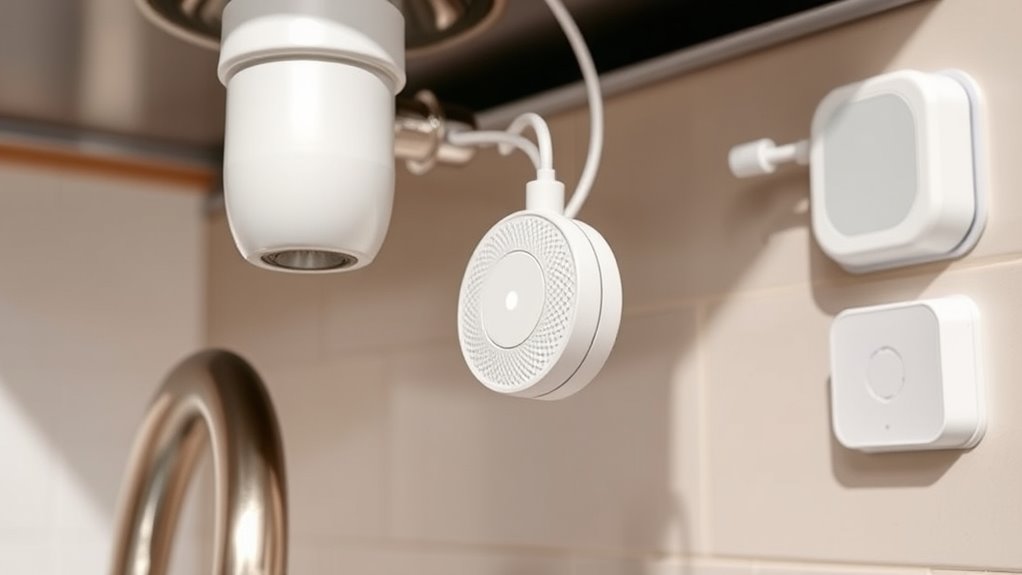
When selecting a smart leak sensor, I consider factors like compatibility with my existing devices, placement options, and alert features. It’s important to think about how the sensor connects, how loud the alarms are, and how long the batteries last. Ensuring it works seamlessly with my smart platform makes all the difference in reliable home protection.
Connectivity Compatibility Options
Choosing the right leak sensor means making sure it can communicate reliably within your smart home setup. Compatibility with ecosystems like Alexa, Google Home, or Apple HomeKit allows seamless integration into your existing automation. Connectivity options such as Wi-Fi, Zigbee, Z-Wave, or LoRa determine the sensor’s range and dependability; long-range technologies like LoRa can cover larger areas and handle obstacles better. It’s also important to take into account your home network’s frequency band—most sensors operate on 2.4 GHz, ensuring stable connections. Additionally, support for offline operation or device-to-device triggers adds reliability during internet outages, especially in complex setups. By matching these connectivity options with your home infrastructure, you ensure your leak sensors work effectively when you need them most.
Sensor Placement Strategies
Effective leak detection starts with strategic sensor placement. I recommend targeting all water-prone areas like under sinks, near water heaters, and around washing machines to guarantee full coverage. Elevate sensors slightly above the floor in spots prone to minor leaks or condensation for better accuracy. Avoid placing sensors behind appliances or furniture, as obstructions can block water contact and cause false negatives. Choose accessible locations to simplify maintenance and battery replacement, keeping sensors operational. Consider environmental factors such as humidity and temperature, which may impact sensor performance. By thoughtfully selecting placement sites, you reduce the risk of missed leaks and false alarms, assuring your smart sensors provide reliable, continuous protection for your home. Proper placement is key to maximizing your leak detection system’s effectiveness.
Alarm Volume and Alerts
Selecting the right leak sensor involves paying close attention to alarm volume and alert options. The alarm sound levels vary from about 85dB to 120dB, ensuring you can find a suitable loudness for your home environment. Many sensors let you adjust the volume, so you can tailor alerts for quiet bedrooms or busy living areas. For larger or noisier spaces, a louder alarm over 100dB guarantees you’ll hear it, even if you’re elsewhere in the house. Some systems also offer multiple notification methods, like app push alerts, SMS, and emails, providing redundancy and flexibility. Proper placement and a clear, audible alarm are key to ensuring alerts are effective, especially in multi-story or open-plan layouts.
Battery Life Expectations
Battery life is a crucial factor to take into account when picking a smart leak sensor, as it directly impacts maintenance and reliability. Most sensors last between 2 and 5 years, depending on their power consumption and usage patterns. Devices using AA or AAA alkaline batteries typically last around 3 to 5 years with normal use, while those powered by lithium coin cells may last up to 2 years. Frequent alerts, continuous detection, or high activity can drain batteries faster. Many sensors include low-battery notifications via app or indicator lights, helping you replace batteries before failure. Proper placement and energy-efficient settings can also extend battery life, reducing how often you need to replace batteries and ensuring your home remains protected without constant maintenance.
Integration With Smart Platforms
Choosing a leak sensor that seamlessly integrates with your existing smart home ecosystem is essential for a smooth and automated experience. Make certain the sensor is compatible with platforms like Alexa, Google Home, Apple HomeKit, or IFTTT, so it can work effortlessly with your current setup. Check which communication protocols it uses—Zigbee, Z-Wave, Wi-Fi, or LoRa—and confirm they’re compatible with your hub or gateway. Consider if it supports integration with smart water shutoff valves or security devices for automatic leak responses. Also, look at the app’s integration options or API access, which allow for custom automations or scripting. Finally, ensure the system can send notifications through your preferred channels—push, SMS, or email—when a leak is detected.
Range and Coverage Limits
Understanding the scope and coverage limits of leak sensors is essential because it directly affects their ability to monitor your entire property effectively. Some sensors use long-range LoRa communication, supporting up to a quarter mile, ideal for large outdoor areas. Others rely on Wi-Fi or proprietary protocols with shorter ranges of 150 to 328 feet, suitable for smaller spaces. The number of sensors a system can support simultaneously also impacts coverage; some can connect over 20 devices, ensuring thorough monitoring. Larger properties, especially basements or outdoor zones, require sensors with extended range or mesh capabilities to maintain reliable detection everywhere. Keep in mind that obstacles like walls, metal structures, or furniture can reduce signal strength, so proper placement and understanding of transmission technology are vital for optimal coverage.
Ease of Installation
When selecting smart home leak sensors, ease of installation can make a big difference in how smoothly you set up your system. Look for models that offer simple, tool-free setup, often requiring just batteries or plug-and-play connections. Clear, step-by-step instructions or a user-friendly app can markedly simplify the process. Wireless options like Wi-Fi, Zigbee, or LoRa eliminate the need for complex wiring or professional help. Features such as QR code scanning or automatic detection can streamline pairing and configuration, saving time and frustration. Additionally, consider the sensor’s design for placement flexibility, allowing you to easily position it in water-prone areas without extra mounting hardware. Overall, a straightforward installation process ensures you’re quickly protected without hassle.
Frequently Asked Questions
How Do Leak Sensors Differentiate Between Minor and Major Water Leaks?
Leak sensors typically differentiate between minor and major leaks through their sensitivity settings and alert thresholds. I find that some sensors can be customized to alert me at specific water levels, while others detect continuous moisture over time. When moisture is just a small drip, the sensor might wait before sounding an alarm, but if water accumulates rapidly or reaches a certain point, it triggers an immediate alert to prevent extensive damage.
Can Smart Leak Sensors Operate During Power Outages?
Yes, smart leak sensors can operate during power outages if they have backup power sources like batteries. I’ve tested sensors that stay active even when the power’s out, giving me peace of mind. But beware—some cheaper models lack this feature, leaving you vulnerable. So, I always choose sensors with reliable backup batteries, knowing they’ll alert me to leaks no matter what happens.
Are Leak Sensors Compatible With Existing Home Automation Systems?
Yes, leak sensors are often compatible with existing home automation systems, but it varies by brand and model. I recommend checking if the sensors support protocols like Zigbee, Z-Wave, or Wi-Fi, which are common in many smart home setups. Most integrate seamlessly with popular platforms like SmartThings, Alexa, or Google Home, making it easy to monitor and respond to leaks through your existing system.
What Is the Typical Battery Life of These Leak Detectors?
Most leak sensors last about 2 to 3 years on their batteries. I’ve found that many models send alerts when the battery runs low, which helps me replace them before any water damage occurs. It’s a good idea to verify the manufacturer’s specs for specific battery life expectations. Regularly testing your sensors ensures they stay reliable, giving you peace of mind knowing your home is protected.
How Do Sensors Handle False Alarms Caused by Humidity or Condensation?
Sensors handle false alarms from humidity or condensation by using advanced algorithms and multi-sensor technology to distinguish between actual leaks and harmless moisture. I’ve found that many models include adjustable sensitivity settings, allowing me to customize alerts. Some sensors also feature temperature and humidity monitoring, which helps prevent false alarms. Overall, I trust these features to reduce unnecessary alerts while still catching real leaks early.
Conclusion
Protecting my home from water damage feels like anchoring a ship safely through stormy seas—these leak sensors are my reliable lighthouse. With the right smart sensor guiding me, I can spot trouble before it floods, turning chaos into calm. Don’t wait for a leak to make waves; arm yourself with one of these top picks and keep your home’s foundation steady and secure, no matter what water throws your way.
